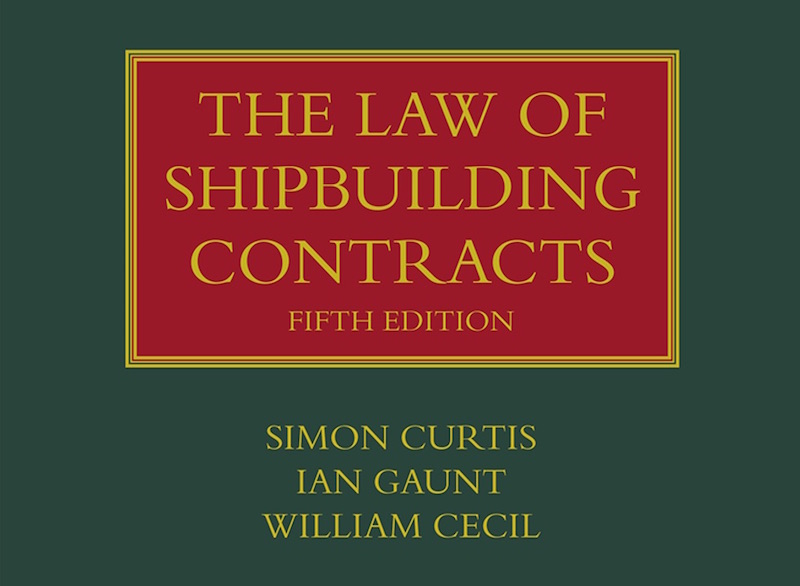20% discount with the attached flyer
Posted on: 3 June 2020
The Law of Shipbuilding Contracts is now available in its 5th Edition. The book is a leading practical guide to explaining the basic principles and law underlying standard contracts used in the shipbuilding industry, and is the go-to work, not just for English solicitors, counsel and arbitrators, but also the lay client, and international lawyers looking for the English perspective. Download a flyer here to benefit from a 20% discount.
In this first update since 2012, the original author, Simon Curtis has brought on board two new co-authors, his partner William Cecil and the well-known arbitrator, Ian Gaunt. Both newcomers have considerable experience in the shipbuilding field as solicitors, and Gaunt also brings further practical insight having managed the shipbuilding programme in-house at Carnival Corporation, and having heard some of the leading shipbuilding disputes as a London arbitrator.
Given there are fewer leading judgements in shipbuilding than in other fields, as most parties opt for arbitration over the courts, the background experience of the three authors is key to the ongoing practical value of this work.
In 1990, Curtis structured the first Edition around a clause-by-clause analysis of the SAJ Form. That was a savvy decision, as the SAJ remains the basic framework for many standard shipbuilding contracts, despite the introduction of competing forms by others such as CMAC and BIMCO. It might have been anticipated that a form designed for the Japanese market, which was commonly subject to London arbitration but used terminology which did not always sit easily with concepts of English law, might decline in use, when faced with competition with the growth of other newbuild markets such as Korea and China. However, the ongoing prominence of the SAJ form has been such that the authors have now dropped a clause-by-clause comparison with the CMAC form, and restricted their comparison to BIMCO’s NEWBUILD form alone.
Since publication of the last Edition, the new build market has not witnessed anything like the dramatic collapse in the aftermath of the 2008 global financial crisis and consequential tsunami of new case law which found its way into the last Edition; nonetheless, the “false dawn” in the bulk carrier market in 2013-4, significant growth in scope and size of new builds in the offshore industry (and collapse in the oil price in 2015); the ongoing need for new generations of ships – think slow-steaming container vessels in response to record oil prices, for example – and the continuing growth of China as a shipbuilding nation – with challenges to enforcement of London awards (mostly unsuccessful) – have resulted in plenty of new material reflected in the new Edition.
Not surprisingly, the background to many disputes still involves a buyer seeking to terminate the shipbuilding contract and the builder seeking damages in consequence and/or looking to prevent the drawdown of a refund guarantee.
One of the most contentious issues in the former context is commonly the builder seeking to blame the buyer, in part at least, for delaying the build programme, thereby impacting the buyers’ claim for liquidated damages for delay or in countering that the buyer is in repudiatory breach by prematurely terminating the contract by reference to the “drop dead date” and/or cumulative delays. The issues in play include whether the builder can identify the buyers’ behaviour as an implied or express breach of a contractual term, and whether notice of such delay is required, and/or whether, if the contract does not provide a comprehensive code relating to delay and notice, whether the implied so-called “prevention principle” can apply. With the advantage that one of the authors was on the tribunal appealed in the leading case Zhoushan v Golden Exquisite, the new edition carefully explains the reasons behind that decision, and cautiously offers criticism of that judgement in opining that, contrary to the decision of Leggatt J. (as was), delays by the buyer should fall within the scope of Article VIII.1 of the SAJ form, and therefore arguments as to the prevention principle have no place under the unamended SAJ form. That view of the authors has subsequently been vindicated by the recent and post-publication decision in Guoxin v Precious, where Butcher J. distinguished Leggatt J.’s judgement on the point. Leave to appeal having been given by Butcher J., it may be interesting to see the view of Lord Leggatt (as is) again, if the case goes yet further and all the way to the Supreme Court.
Another contentious issue in the past few years has been in defining the nature of Refund Guarantees and whether they give rise to an “on demand” liability, or, as was argued in Spliethoff v. Bank of China, the liability was secondary, as with a true guarantee. This argument was run by the Bank in the Spliethoff case in defence of a claim under the Refund Guarantee, after the builder muddied the waters by bringing parallel proceedings in China to the London arbitration. The Bank argued the Refund Guarantee could not be drawn down, pending resolution of the parallel proceedings. As the authors explain, Carr J decided the Refund Guarantee is an on demand hybrid, the difference to other on demand guarantees being one of timing not substance, such that the proceedings in a third party jurisdiction relating to the SBC are of no consequence to a claim under the Refund Guarantee.
Other updates in the new Edition cover environmental law, leasing structures, innominate terms and the scope of warranty (Neon Shipping), the definition of consequential loss (Star Polaris), plus important and practical guidelines in arbitration practice such as the seat of the arbitration, partial and interim awards, enforceability and guidelines to the interpretation of English law. There are also new sections on termination at the buyer’s convenience, exclusion clauses (Transocean v. Providence) and helpful warnings of possible pitfalls when drafting options for additional vessels, in the light of Teekay v STX.
In addition to covering these important developments in the context of standard shipbuilds, the authors have also added separate stand-alone sections in the new Edition to address particular thorny problems which are more likely to arise in Offshore construction projects, such as design, buyers’ supply, variation procedures, voluntary termination, expansion/reduction of the work scope, and trials and completion; areas where the complexity of the build project, and a greater involvement of the buyer in the design process, may require different considerations to the standard build contract.
In this context, the new Edition may not be able to offer such a comprehensive review of all of the issues which can arise in an Offshore context, as it can for standard shipbuilding, especially given the increasing use of entire bespoke contracts in the Offshore field; however, even in the case of such bespoke contracts, the origin of many clauses still derive from the original SAJ wording and the book still plays a valuable role in highlighting the issues and the law.
In the light of the various updates, the 5th Edition of this work will therefore provide an important addition to the library of anyone involved in the Shipbuilding and Offshore field who wishes to keep abreast of the latest legal developments.




